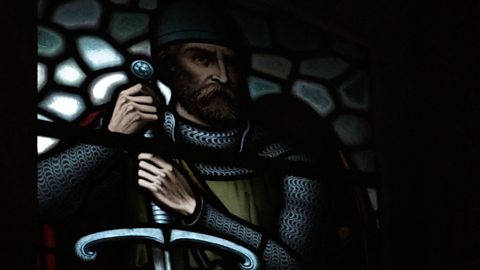William Wallace, otherwise known as Braveheart, was a 13th-century Scottish warrior and politician who became a legendary figure in Scottish history and the independence movement. But what did he do to become a legend? And does he merit this status?
This is the Wallace Monument in Stirling, in Scotland. It's a celebration of a great Scottish hero, William Wallace. It dominates the skyline over Stirling. Surely this source is going to tell us everything we need to know about the man. It's been built near the site of Wallace's most famous victory over the English, the Battle of Stirling Bridge, in 1297. It was constructed in the later 19th century, a time when there was a big revival of interest in Scottish history and identity.
The whole monument itself feels very much like a church. It's got stained-glass windows. They want us to worship William Wallace. In the middle of the room is a huge sword which some people claim was brandished by Wallace. The first thing that strikes me is - it's rather large, and it does make me question how likely it is he would have been able to wield this thing. If we assume that this was his sword, as the people who put it here want us to assume, then we have to get an impression of Wallace as this huge man, somebody who is so strong he was capable of holding this thing.
So we have to ask, was William Wallace really as significant as this monument makes out? My next source is held in Edinburgh, at the National Library of Scotland. This particular source is a poem, written around the 1470s, by a poet known as Blind Harry. And it's been beautifully written out here in old Scots. It sets out the image of Wallace as a superhuman patriot who fought the English. Here we've got a passage that says…
We get this image that we got with the Hollywood movie, Braveheart. It jumps out from this poem. It also says some other things, though, which are a little bit problematic. So one of the things that this particular source says is that Wallace won the Battle of Falkirk. But various other sources suggest that the Scots actually lost that battle. So why is the poet telling fibs?
So far, I've seen two sources. The monument and Blind Harry's poem. Both seem to exaggerate Wallace's achievements. These sources are the work of his supporters. But I wonder how he was regarded by his enemies in England. In 1305, English troops finally caught William Wallace, and they brought him here to London, where they took him to the Tower. A few weeks later, he was executed for high treason.
I'm here at Kew, at the National Archives in London, not far from where Wallace was executed. And buried deep within the archive, there's a fascinating account of the execution. I have in front of me one of King Edward's Exchequer Pipe Rolls, and it outlines, in Latin, the costs of the execution. Up here, we have the key paragraph, that outlines all the gruesome details. He was hanged until he was almost dead, cut down, his body was cut open, his innards were taken out and burned before him. And then he was cut into four sections. And those pieces were taken to four different towns.
King Edward's Exchequer Rolls generally listed government expenses. But Wallace's entry goes into more detail. It says that it cost 61 shillings and ten pence to execute Wallace. This is no small sum of money. So why have they gone to this expense? Well, the source says that Wallace was a robber, a rebel and a traitor, that Wallace falsely sought to call himself King of Scotland.
So it's clear from this Pipe Roll that, for the English, who were at war with the Scots, Wallace WAS a very important figure. And capturing and executing him was a major victory. We know that sources can distort the truth, and it's coming here to England and seeing what William Wallace's enemies made of him that's really convinced me about the significance of the man.
OK, so the Wallace Monument and the great man's sword were clearly exaggerations, and the Blind Harry poem made claims about his battle victories that we know to be false. But the Pipe Roll, which showed the lengths that his enemies went to to get rid of the man, really shows he was somebody of significance. William Wallace was someone that some people here in England were glad to be rid of - for good.
Video summary
Dr Sam Caslin begins her investigation into the personality of Elizabeth I by examining a source held at The National Archives at Kew.
“The Great Seal” is one of the official images of Queen Elizabeth.
It is preserved in beeswax and was attached to the most significant official documents of the time to prove that it had come from the Queen.
This particular seal is from 1586, at the height of Elizabeth’s power and the official image shows her in a very grand pose holding an orb to represent her spiritual power and a sceptre to represent her power on earth.
Caslin then unearths a second source at Kew, this time from 1554 when Elizabeth was only 20 years old and not yet Queen.
It is a letter to her older sister, Mary who was then Queen and in the letter Elizabeth is pleading for her life.
She has been implicated in a plot to overthrow her sister, but Elizabeth eloquently defends herself in the letter, claiming that she was not part of the plot.
The letter shows both Elizabeth’s vulnerability and her tenacity.
The two sources thus show very different sides to Elizabeth at very different stages in her life.
This clip is from the series Hunting for History.
Teacher Notes
Pupils could be asked to look at images of present day prominent figures and to consider how these figures manage their image.
After watching Sam analyse source 1 they could then be asked to say whether they think Elizabeth was motivated by fear, ambition, or something else.
After they watch source 2 they can decide whether they want to change their minds.
This clip will be relevant for teaching KS3 History in England, Wales and Northern Ireland and 4th level People, past events and societies in Scotland.
The Slave Owner. video
An exploration of how sources allow historians to understand more about the life of a wealthy Welsh slave owner.
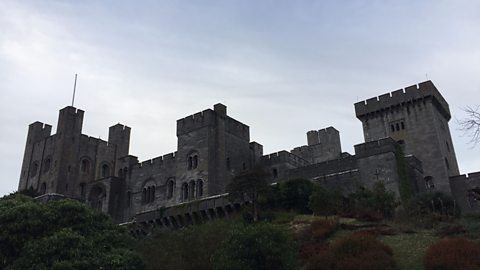
The History of Women's Football. video
Exploring sources that reveal the remarkable success of the Dick Kerr’s ladies football team during World War One.
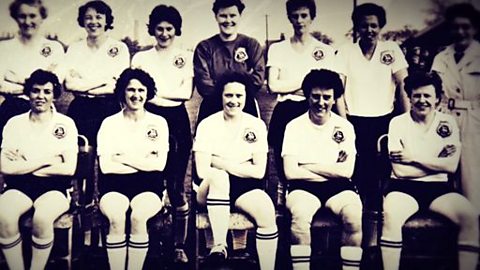
Magna Carta. video
A look at what sources can tell us about the importance and origins of Magna Carta.

The Cuban Missile Crisis. video
Exploring what historical sources reveal about how close Britain came to nuclear war in the early 1960s.
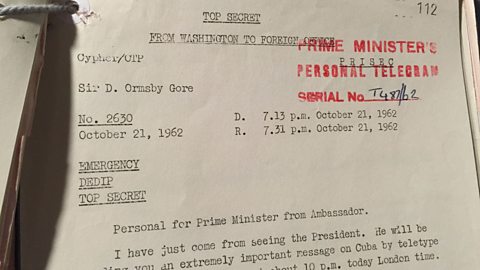
What was life like for young people in 1960’s Britain? video
An exploration of historical sources from the 1960's reveals deep seated changes in attitudes among young people.
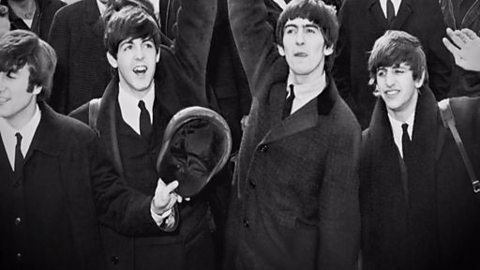
William Wallace. video
A look at how sources can help separate the myth from the man that is William Wallace.
